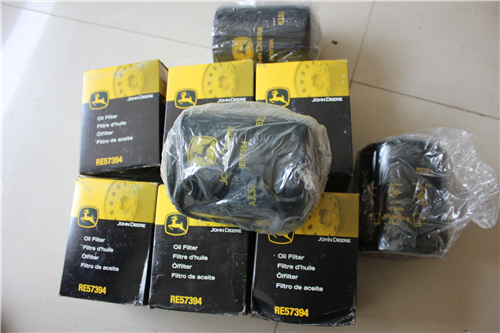详细描述
John Deere约翰迪尔强鹿柴油机活塞和连杆的拆装技术手册
Remove Pistons and Connecting Rods
If engine is to be removed from the machine, see yourmachine technical manual.
CAUTION: Do not drain engine coolant until itcools below operating temperature. Then slowlyloosen block drain valve to relieve any
pressure.
1. Drain coolant and engine oil.
NOTE: If engine is to be completely disassembled, seeENGINE DISASSEMBLY SEQUENCE in Group010.
2. Remove cylinder head. (See REMOVE CYLINDERHEAD in Group 020 for two valve head or REMOVECYLINDER HEAD in Group 21 for four valve head.)
3. Remove camshaft followers and keep in order forreassembly in same position.
4. Clean all foreign material from cylinder block top deck.
IMPORTANT: Cap screws and washers must betightened to the correct specification toachieve an accurate reading whenchecking liner standout (height aboveblock), as detailed later in this group.
5. Use short cap screws (A) and 3 mm (1/8 in.) thickwashers (B) to bolt down cylinder liners (C). Fasteneach liner in two locations. Tighten cap screws to 68
N•m (50 lb-ft).
NOTE: Do not rotate crankshaft with cylinder headremoved unless liners are fastened down.
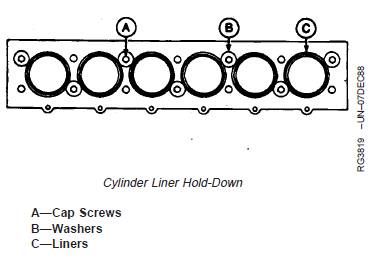
NOTE: Always follow manufacturer’s directions providedwith ridge reamer.
6. Remove carbon from liner bore with a scraper or ridgereamer (A). Use compressed air to remove loosematerial from cylinders.
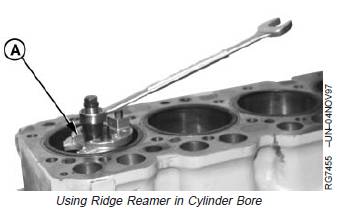
7. Remove oil pan, oil pump, and pick-up tube. (SeeREMOVE, INSPECT AND INSTALL OIL PUMPPICK-UP TUBE ASSEMBLY in Group 060.) (SeeREMOVE ENGINE OIL PUMP in Group 060.)
8. Mark rods, pistons, and caps to ensure correctassembly in same location.
IMPORTANT: Keep inserts with their respective capsfor rod and main bearings.
9. Remove all rod caps (A) with bearings.
10. Measure rod bearing-to-journal oil clearance withPLASTIGAGEâ before removing piston and rodassembly. Record measurements. (See INSPECTAND MEASURE CONNECTING ROD BEARINGS,later in this group.)
NOTE: Use PLASTIGAGEâ as directed by themanufacturer. PLASTIGAGEâ will determinebearing-to-journal oil clearance, but will notindicate the condition of either surface.
A—Rod Caps
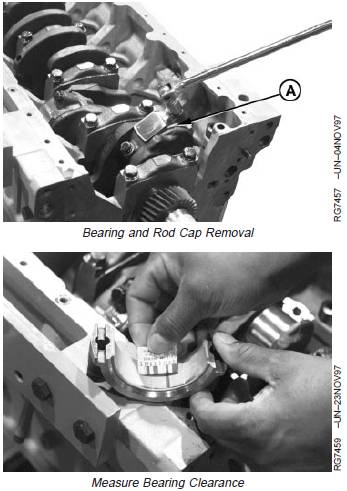
IMPORTANT: Hold onto piston to prevent piston fromdropping. Piston will drop once pistonrings have cleared cylinder liner.If liners are to be reused, be extremelycareful not to let connecting rod hitliner bore when removing piston androd assembly.
11. Gently tap piston through top of cylinder block fromthe bottom.
12. Remove pistons and rods from engine.
13. If piston rings are to be reused, measure piston ringend gap and compare to the following specifications:Piston Rings—4045DF, TF150 and 6068DF, TF150 Engines —Specification
No. 1 Compression—End Gap ........... 0.33—0.58 mm (0.013—0.023 in.)
No. 2 Compression—End Gap ........... 1.24—1.49 mm (0.049—0.059 in.)
No. 3 Oil Control—End Gap ............... 0.30—0.56 mm (0.011—0.022 in.)
Piston Rings—4045TF250 and 6068TF250 Engines—Specification
No. 1 Compression—End Gap ........... 0.33—0.64 mm (0.013—0.025 in.)
No. 2 Compression—End Gap ........... 0.75—1.00 mm (0.030—0.039 in.)
No. 3 Oil Control—End Gap ............... 0.33—0.64 mm (0.013—0.025 in.)
Heavy Duty Piston Rings—Specification
No. 1 Compression—End Gap ........... 0.33—0.59 mm (0.013—0.023 in.)
No. 2 Compression—End Gap ........... 0.89—1.14 mm (0.035—0.049 in.)
No. 3 Oil Control—End Gap ............... 0.33—0.59 mm (0.013—0.023 in.)
14. Remove all main bearing caps with bearings. Removecrankshaft from engine.
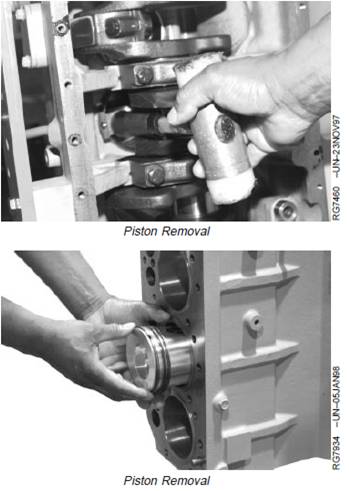
400-100-8969 15088860848
0574-26871589 15267810868
0574-26886646 15706865167
0574-26871569 18658287286



 English
English Espaol
Espaol Franais
Franais 阿拉伯
阿拉伯 中文(简)
中文(简) Deutsch
Deutsch Italiano
Italiano Português
Português 日本
日本 韩国
韩国 български
български hrvatski
hrvatski esky
esky Dansk
Dansk Nederlands
Nederlands suomi
suomi Ελληνικ
Ελληνικ 印度
印度 norsk
norsk Polski
Polski Roman
Roman русский
русский Svenska
Svenska
